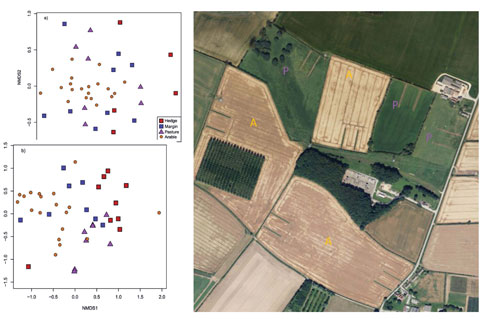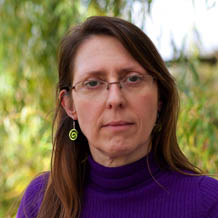Professor Thorunn Helgason
Former Deputy Head of Department (Teaching and Staff)
Research
Microbes are key functional groups in ecosystems, acting as drivers of major transitions in nutrient cycles. As pests, pathogens and symbionts, may be regulators of population dynamics in plants and animals. My research focuses on the study of microbial diversity and function in field systems, where we can study the effect of realistic perturbations in the environment. Using modern high throughput sequencing and bioinformatics, we reveal the huge variety of microbes inhabiting ecosystems across the globe. Through extensive collaborations with UK and international researchers, we shed light on the role microbes play in the response of ecosystems to anthropogenic changes in landuse, climate and management.

In the SoilBioHedge consortium, we implemented a farm scale land use experiment investigating diversity across four landuses within the farm: Arable, Pasture, Field margin and Hedgerow. Root samples from plants growing in the four landuses were analysed using PCR and Illumina MiSeq amplicon sequencing to determine the diversity of total fungi (Fig 1A) and the symbiotic arbuscular mycorrhizal fungi (Fig 1B). Layout of the fields at the University of Leeds Farm Research Unit is shown in Fig 1C. This analysis shows that the arable crop plants are more similar to one another (shown by the tighter clustering in both ordinations) for both groups of fungi, and that even across short spatial scales, the hedgerows are more diverse and are strikingly different to the other landuses, suggesting they are an important reservoir of microbial diversity (and by extension, function) within arable landscapes. (Data from Holden et al. 2019 doi:10.1016/j.agee.2018.11.027)

Tropical forests are some of the most diverse habitats on earth, but the microbial diversity is only now being explored thanks to advances in DNA sequencing. The two major plant-fungus symbioses, the ectomycorrhizas and the arbuscular mycorrhizas have very different abilities to take up nutrients from soil, and associate with distinct groups of plants. We have been investigating the link between the soil niche preferred by the fungi and the plants they colonise, to see if the distribution of the plants can be linked to the niche of fungi with which they associate.
Teaching and scholarship
![]()
In the modern digital era, information is easy to find: Universities are no longer gatekeepers of information – the challenge for university education is to develop students’ skills to interpret and process information. In my teaching, I strive to encourage students to question information and data, and to develop the skills and confidence to analyse and interpret it.
![]()
I deliver first year lectures in plant ecophysiology, where my primary aim is to open students to the fascinatingly complex range of solutions plants have evolved to survive the changing environments that surround them. In the third year, I focus on microbial diversity in the environment, and how old, and new, sequencing methods revolutionised our understanding of microbes. Underpinning my ecology teaching is an effort to engage students in natural history, by developing field observation and identification skills through practicals and field courses.
![]()
Small group teaching is an opportunity to explore science in different ways, and in particular devoting time to reflect on how we study, rather than only the what. Using student led topics, we use research, writing to various audiences, and presentations, to think about the process of writing and communication, and to understand that it takes practice and reflection to improve. Always in the area of ecology, subjects have included upland bracken control, experiments to show whether there is any truth in the folklore that spiders are scared of conkers, and whether bacteria ever really go extinct.
![]()
My research focusses on studying the ecology of microbes in field systems. My projects reflect this, giving students the opportunity to design novel experiments to test how plants and microbes interact. BSc projects focus on how soil functions and microbial diversity respond to climate change. I offer Master’s project students the opportunity to select samples from our growing archive of samples from around the globe, and to design experiments that develop skills in DNA analysis and bioinformatics.


